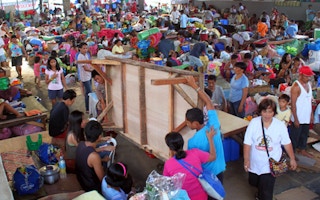Extreme weather-related disasters displaced some 42 million people in Asia Pacific in the past two years and such events will only become more frequent with climate change, said a new report by the Asian Development Bank (ADB) on Tuesday.
Climate change will cause a surge in migration in this century and governments in the region must implement measures today to “stave off future humanitarian crisis”, said ADB.
ADB vice president for knowledge management and sustainable development, Bindu Lohani, said that migration was a neglected topic in climate change discussions and that the report is the first of its kind to suggest policy tools to help governments manage future migration caused by environmental factors.
Launching the report on the sidelines of the second Asia Pacific Climate Change Adaptation Forum in Bangkok, he told reporters that good adaptation measures - ways of preparing for the future effects of climate change - could help countries avoid migration.
He added that if this migration can be clearly linked to climate-related disasters, countries will also be able to tap into the Green Climate Fund to fund adaptation measures. The Green Climate Fund is a global pot of money funded by developed nations for climate action to the tune of $100 billion a year by 2020.
“It’s a new policy message we’re sending here,” he said. “The environment is becoming a significant driver of migration in Asia and the Pacific as the population grows in vulnerable areas, such as low-lying coastal zones and eroding river banks… Governments should not wait to act.”
“By taking steps now, they can reduce vulnerability, strengthen resiliency, and use migration as an adaptation tool rather than let it become an act of desperation,” Mr Lohani added.
The report, Addressing Climate Change and Migration in Asia and the Pacific, noted that Asia Pacific is home to six of the world’s top ten countries most vulnerable to climate change.
Bangladesh tops the list, followed by India (2nd), Nepal (4th), Philippines (6th), Afghanistan (8th) and Myanmar (10th).
Natural disasters affected an annual average of more than 200 million people in the region between 2001 and 2010. By 2020, 13 of the world’s 25 mega cities, most of them in low-lying coastal areas, will be in this region. Climate change will expose millions to flooding and the threat of displacement, noted the report.
It pointed out that while most migration will continue to take place within countries, more migration will occur across borders and governments will need to cooperate more closely on migration matters.
The report highlighted the urgency of increasing the resilience of climate-threatened communities - a recurring theme of the two-day forum that was cancelled last year due to Bangkok’s severe flooding and had to reconvene this year.
The report also noted that reducing transfer fees for migrant remittances - sending money back to their home country - can provide additional revenue for communities to adapt to the effects of climate change.
The report recommended governments work with the private sector to introduce insurance tools to attract investors into financing and managing the risks posed by climate change.
Migration policy officer Dina Ionesco from the International Organization for Migration (IOM) said at the launch that ADB’s report was timely as governments are increasingly aware of climate-related migration trends.
But she noted that the numbers only tell one side of the story. The report cites displacement figures only from immediate disasters such as storms, cyclones, resulting landslides and extreme weather, but there are longer-term migration trends due to phenomenons such as desertification or sea level rise that have not been included.
The strong focus on displacement of people in natural disasters occurs because it “is very visible”, she said. “But we want to highlight that these hotspots (climate vulnerable countries) have a mix of structural issues that lead to migration.”
“It can be a choice, or it could be forced - where people run away to save their lives,” she added. “The point is to plan and manage this migration… so it is a choice for people.”










